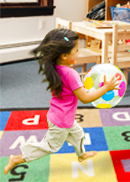Behaviour
Caring for babies
Bottle feeding
Changing a nappy
Cleaning and sterilising bottles
Daily cleaning tasks
Helping new children settle in
Preparing for a nappy change
Sleep patterns – babies
Sleep routines – babies
Toilet training
Caring for children
Allowing time for practice
Dressing/undressing
Mealtimes
Nappy change
Packing away/caring for the environment
Sleep/rest time
Toileting
Common self-help milestones
Tips for sleep and rest time
Self image
Communication
Body language
Limits and guidelines
Ways children communicate
Greeting children and families
Modelling appropriate communication
Questioning
Verbal and non–verbal communication
Acknowledging children's feelings
Listening attentively
Communicating with Aboriginal and Torres Strait Islander parents/carers
Development
Allowing time for practice
Dressing/undressing
Mealtimes
Nappy change
Packing away/caring for the environment
Sleep/rest time
Toileting
Common self-help milestones
Creative development
Language development
Modelling positive relationships
Physical development
Sharing and taking turns
Sleep patterns – babies
Sleep routines – babies
Encourage independent problem solving
Fundamental movement skills
Health, hygiene and safety
Coping with stress
Correct manual handling principles
Daily cleaning tasks
Hand washing
Hand washing poster
Manual handling overview
Toilet training
Safety checklist
Learning experiences and play
Environmentally friendly learning experiences
Learning experiences for different development areas
Creative resource materials
Arranging the environment to facilitate learning and pleasure
Indoors and outdoor areas
Creating a positive physical environment
Legal and ethical issues
Child abuse case studies
How do I recognise when a child or young person is at risk?
Tips on dealing with disclosures
Observation methods
Arranging Experiences (PDF 351Kb)
Recording observations
Rules for making observations
What you can learn from observations
Programming
Children’s interests, strengths, needs and skills
Extending the children’s interest in dinosaurs
Objective observation
Planning an OSHC environment
Behavior management plan
Planning enjoyable experiences
Planning experiences for 0 - 2 years age group
Planning experiences for 2 - 3 years age group
Planning experiences for 3 - 5 years age group
Limits and guidelines
Before you can expect the children in your care to behave appropriately at your centre, the guidelines and limits you want children to adhere to need to be stated clearly and up front.
You must ensure that children are aware of these guidelines, and the limits on their behaviour. If the children are not aware, they will not know what is appropriate and what is not.
Communicating behaviour limits and guidelines
These guidelines and limits must be clearly communicated, and role modelled by yourself and the other caregivers in your centre. By being upfront you know that everyone has been informed and therefore there should be no misunderstandings, or 'not knowings.'
To be clear, you need to ensure that the children have heard and understood you when you explain the limits and guidelines. If necessary, have them repeat what you have told them so you can be sure. Ask them what the limits and/or guidelines mean to them, so you can see if the message has been understood.
Limits need to be worded in a positive way to allow children to understand what they can do.
Applying limits and guidelines to children's behaviour
Applying these limits and guidelines to children's behaviour involves directing the children towards the desired behaviour in a positive and caring way. Directing (or redirecting) behaviour is similar to refocusing someone's attention - you do it to change the pathway on which they are heading. This does not always mean that the pathway they are heading on is wrong, it just may be inappropriate at that time.
For younger children, these guidelines and limits are important as they are still developing their understanding of what's right and wrong. Knowledge of why the limit is in place is equally important for older children, who are more likely to already be aware of what behaviour is acceptable. By understanding the reasons why they exist, the children are more accepting and willing to respect the limit.

For example, if you were asking a child to stop running in the centre, if you explained why running is dangerous it would help them to understand why the limit exists.
Redirecting children’s attention
One of the techniques used by caregivers to modify a child's inappropriate behaviour involves redirecting the child to something else more appropriate; in other words, get them to focus on something else.
When redirecting a child’s behaviour, the language you use needs to be appropriate to their age and stage of development. This means that you will need to alter your approach accordingly. You also need to ensure that you are modelling appropriate behaviours yourself - in other words, 'practise what you preach.'
Like many things in life, redirection will become a habit after you have performed it a few times, you just need to break the old habit first if you have one.
Responding to children's behaviour according to policies and procedures
To ensure that limits and guidelines on children's behaviour are consistent and appropriate in the centre, you will find a manual that will describe to you the policies and procedures the centre has on various topics. One of these should be 'Guiding children's behaviour.’
Before a centre can be accredited and recognised as having a high quality service, they must have a policy and procedure on guiding children's behaviour. This is required by the National Childcare Accreditation Council.
Before you start work at any child care centre, always ask to see their policy on guiding children's behaviour so that you understand the guidelines and limits that you will be required to support and monitor.
For more information you can have a look at the Cybertots policy on Guiding children's behaviour. You can find this on the Cybertots Intranet under Policies.